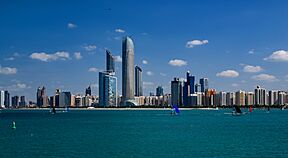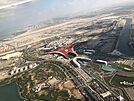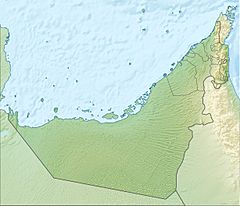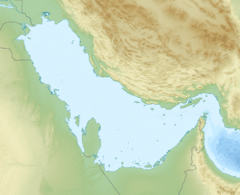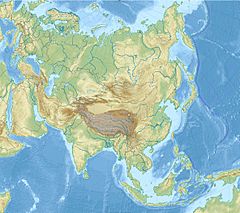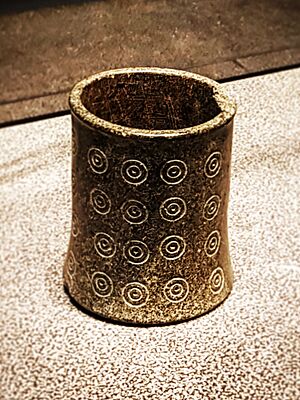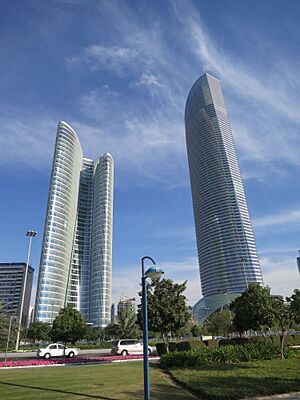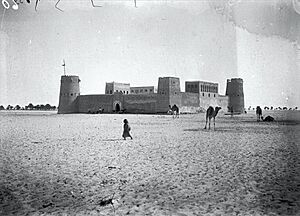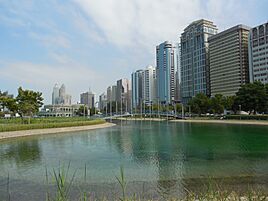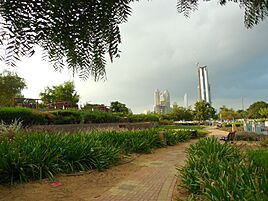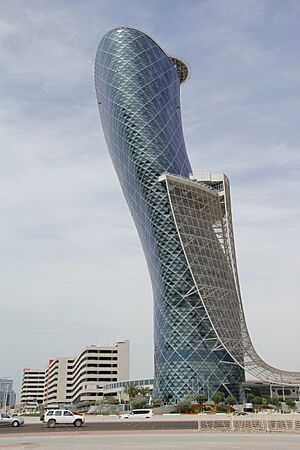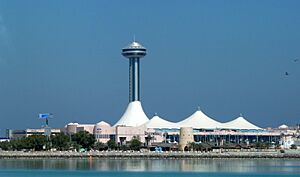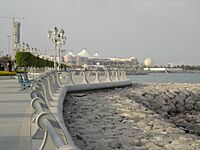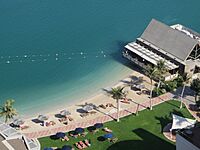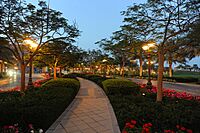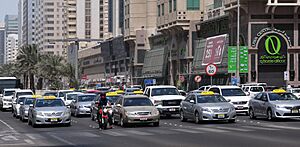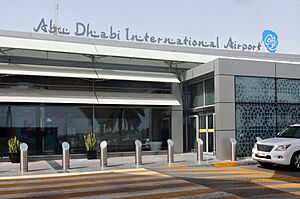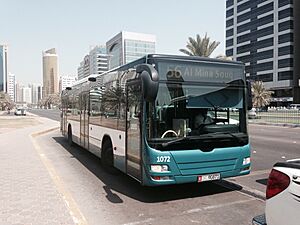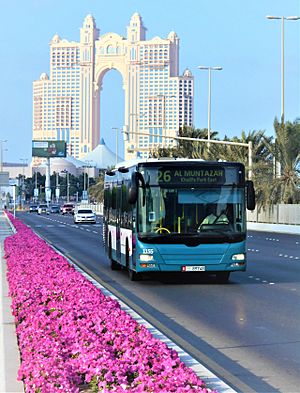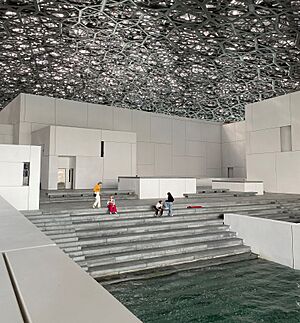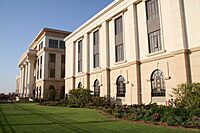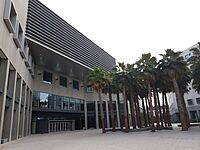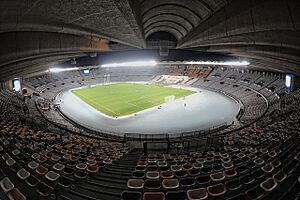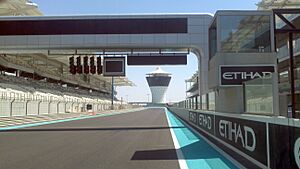Abu Dhabi facts for kids
Quick facts for kids
Abu Dhabi
أبوظبي
ʾAbū Ẓabī |
|||||
|---|---|---|---|---|---|
|
From top, left to right: Abu Dhabi's skyline, Emirates Palace, Al Ras Al Akhdar, Sheikh Zayed Grand Mosque, Ferrari World
|
|||||
|
|||||
| Country | |||||
| Emirate | |||||
| Municipal region | Central Capital District | ||||
| Government | |||||
| • Type | Municipality | ||||
| • Body | Abu Dhabi City Municipality | ||||
| Area | |||||
| • Total | 972 km2 (375 sq mi) | ||||
| Elevation | 27 m (89 ft) | ||||
| Population
(2023)
|
|||||
| • Total | 1,570,000 | ||||
| • Density | 1,615/km2 (4,183/sq mi) | ||||
| Demonyms | Abu Dhabian, Dhabyani | ||||
| GDP | |||||
| • Total | US$ 118.4 billion (2023) | ||||
| • Per capita | US$ 76,600 (2023) | ||||
| Time zone | UTC+4 (UAE Standard Time) | ||||
Abu Dhabi is the capital city of the United Arab Emirates (UAE). It is the main city of the Emirate of Abu Dhabi. It is also the UAE's second-largest city by population, after Dubai. The city sits on a T-shaped island that reaches into the Persian Gulf.
Abu Dhabi is on an island in the Persian Gulf. Most of the city and the Emirate are on the mainland. This mainland is connected to the rest of the country. In 2023, about 2.5 million people lived in Abu Dhabi's city area. The whole Emirate of Abu Dhabi had 3.8 million people. The Abu Dhabi Investment Authority is based here. In 2022, it was the world's 3rd largest wealth fund. Abu Dhabi manages over a trillion US dollars in various wealth funds.
Abu Dhabi is home to many government offices. It is where the UAE Government and the Supreme Council for Financial and Economic Affairs meet. The UAE's President lives in Abu Dhabi. He is a member of the Al Nahyan family. Abu Dhabi has grown very fast. It has huge oil and gas reserves. This has made it a big, modern city. It is the country's center for politics and industry. It is also a major place for culture and commerce. Abu Dhabi makes up about two-thirds of the UAE's economy.
Contents
Discovering Abu Dhabi's Past
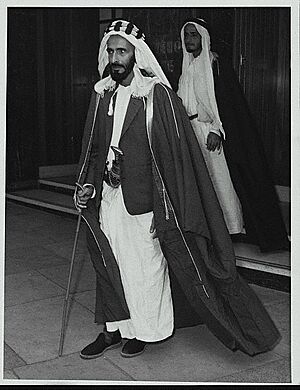
The land around Abu Dhabi has signs of old civilizations. One is the Umm Al Nar culture, from around 3000 BC. Other old settlements were found outside the city. These were in the eastern and western parts of the Emirate. On December 2, 1971, Abu Dhabi joined six other emirates. Together, they formed the United Arab Emirates (UAE). Sheikh Zayed bin Sultan Al Nahyan became the first President of the UAE.
What Does "Abu Dhabi" Mean?
The word "Abu" means "father" in Arabic. "Dhabi" is the Arabic word for gazelle. So, Abu Dhabi means "Father of Gazelle." People think this name came from the many gazelles in the area. There is also a folk tale about Shakhbut bin Dhiyab al Nahyan that tells how the name came to be.
The Al Nahyan Family's Story
The Bani Yas tribe first lived in the Liwa Oasis. This was the most important tribe in the area. It had over 20 smaller groups. In 1793, the ruling Al Bu Falah group moved to Abu Dhabi island. They moved because they found fresh water there. The Al Nahyan family is the oldest family in this group. They are now the ruling family of Abu Dhabi. They have been very important in the UAE for centuries. They helped develop the emirate. Sheikh Mohamed bin Zayed Al Nahyan has helped make Abu Dhabi a center for culture in the Arab world.
The Pearl Trade
Before oil was found, pearl diving was a huge business. The Persian Gulf was known as the best place for pearls. The pearl industry grew a lot from the late 1800s to the early 1900s. But it is believed to have started about 7,000 years ago. Pearl divers would dive for one to three minutes. They could do this up to thirty times a day. They were not allowed to use air tanks or machines. Divers wore a leather nose clip. They also had leather covers on their fingers and big toes. This protected them while they looked for oysters. Divers were not paid daily. They got a share of the season's earnings. The main pearl diving trips happened between May and September each year. Summer was the busiest time.
The Trucial Coast Era
In the 1800s, Great Britain made agreements with the sheikhs of the Arab States in the Persian Gulf. These agreements were called "truces," which gave the coast its name. Britain became very powerful in the area. Britain wanted to protect its trade route to India from pirates. That is why the area was first called the "Pirate Coast." After piracy stopped, Britain still wanted to keep other powerful countries out of the region. After leaving India in 1947, Britain kept its influence in Abu Dhabi. This was because people became interested in the oil in the Persian Gulf.
Finding Oil for the First Time
In the mid-to-late 1930s, the pearl trade slowed down. But interest in oil grew. On January 5, 1936, the Abu Dhabi Petroleum Company (PDTC) signed a deal. They agreed with the ruler, Sheikh Shakhbut bin Sultan Al Nahyan, to look for oil. Another deal was signed in January 1939 for 75 years. But exploring for oil in the desert was hard. In 1953, D'Arcy Exploration Company got a deal to look for oil offshore. This company later became Abu Dhabi Marine Areas (ADMA). In 1958, they found oil in the Umm Shaif field. This was done using a drilling platform in the sea. In 1959, PDTC found oil on land at Murban No.3.
ADMA found the Bu Hasa oil field in 1962. They found the Lower Zakum oil field in 1963. Today, other important oil fields are Asab, Sahil, Shah, al-Bunduq, and Abu al-Bukhoosh. In 1966, Dubai found its first oil in the Fateh oil field. Money from oil helped the emirate grow a lot.
Abu Dhabi's Location and Environment

The city of Abu Dhabi is on the southeastern side of the Arabian Peninsula. It is next to the Persian Gulf. The city is on an island less than 250 meters from the mainland. It is connected to the mainland by the Maqta and Mussafah Bridges. A third bridge, Sheikh Zayed Bridge, opened in late 2010. It was designed by Zaha Hadid. Abu Dhabi Island is also linked to Saadiyat Island by a five-lane highway bridge. The Al-Mafraq bridge connects the city to Reem Island. It was finished in early 2011. This bridge has 27 lanes. It can handle about 25,000 cars per hour. There are three main bridges in this project. The biggest one has eight lanes. Four lanes go out of Abu Dhabi city, and four come in.
Most of Abu Dhabi city is on the island. But it has many neighborhoods on the mainland. Examples are Khalifa City A, B, and C; Al Raha Beach; Al Bahia City A, B, and C; Al Shahama; Al Rahba; Between Two Bridges; Baniyas; Shamkha; Al Wathba and Mussafah Residential.
The waters around Abu Dhabi have the world's largest group of Indo-Pacific humpbacked dolphins. To the east of the island is the Mangrove National Park. It is on Al Qurm Corniche. Al-Qurm means "The Mangrove" in Arabic.
Abu Dhabi's Climate
Abu Dhabi has a hot desert climate. You can expect sunny blue skies all year. From June to September, it is very hot and humid. Temperatures are often above 40°C, especially in July and August. Sometimes, sandstorms happen, making it hard to see. Because of high humidity, especially near the coast, it can feel even hotter than it is. Dust storms are common in hot, dry months. They affect air quality and how far you can see.
The cooler season is from November to March. It is warm to mild then. During this time, there can be thick fog on some days and a few days of rain. January is usually the coolest month. August is the hottest. The Tropic of Cancer goes through the emirate. So, the southern part is in the Tropics. But even though the coolest month averages 18.8°C, it is too dry to be called tropical.
| Climate data for Abu Dhabi (International Airport) 1991-2020 | |||||||||||||
|---|---|---|---|---|---|---|---|---|---|---|---|---|---|
| Month | Jan | Feb | Mar | Apr | May | Jun | Jul | Aug | Sep | Oct | Nov | Dec | Year |
| Record high °C (°F) | 34.3 (93.7) |
38.1 (100.6) |
43.0 (109.4) |
44.7 (112.5) |
46.5 (115.7) |
50.0 (122.0) |
49.3 (120.7) |
49.2 (120.6) |
47.7 (117.9) |
43.1 (109.6) |
37.9 (100.2) |
33.8 (92.8) |
50.0 (122.0) |
| Mean daily maximum °C (°F) | 24.5 (76.1) |
26.5 (79.7) |
29.7 (85.5) |
35.0 (95.0) |
39.6 (103.3) |
41.4 (106.5) |
42.5 (108.5) |
43.4 (110.1) |
40.9 (105.6) |
36.6 (97.9) |
31.0 (87.8) |
26.5 (79.7) |
34.8 (94.6) |
| Daily mean °C (°F) | 19.1 (66.4) |
20.6 (69.1) |
23.4 (74.1) |
27.7 (81.9) |
31.8 (89.2) |
33.7 (92.7) |
35.5 (95.9) |
35.9 (96.6) |
33.3 (91.9) |
29.7 (85.5) |
25.2 (77.4) |
21.1 (70.0) |
28.1 (82.6) |
| Mean daily minimum °C (°F) | 13.8 (56.8) |
15.9 (60.6) |
17.5 (63.5) |
21.1 (70.0) |
24.6 (76.3) |
27.0 (80.6) |
29.7 (85.5) |
30.2 (86.4) |
27.4 (81.3) |
23.7 (74.7) |
19.6 (67.3) |
15.7 (60.3) |
22.2 (71.9) |
| Record low °C (°F) | 5.6 (42.1) |
5.4 (41.7) |
8.4 (47.1) |
11.3 (52.3) |
16.6 (61.9) |
19.8 (67.6) |
22.2 (72.0) |
24.9 (76.8) |
20.4 (68.7) |
15.0 (59.0) |
13.1 (55.6) |
7.3 (45.1) |
5.4 (41.7) |
| Average precipitation mm (inches) | 12.5 (0.49) |
8.1 (0.32) |
12.9 (0.51) |
5.2 (0.20) |
0.3 (0.01) |
0.0 (0.0) |
0.7 (0.03) |
0.1 (0.00) |
0.0 (0.0) |
0.2 (0.01) |
2.4 (0.09) |
7.8 (0.31) |
50.2 (1.97) |
| Average precipitation days (≥ 1 mm) | 2.8 | 2.0 | 2.9 | 1.4 | 1.0 | 0.0 | 1.0 | 1.0 | 0.0 | 1.0 | 2.2 | 2.4 | 17.7 |
| Average relative humidity (%) | 68 | 67 | 63 | 58 | 55 | 59 | 61 | 63 | 64 | 65 | 65 | 68 | 63 |
| Average dew point °C (°F) | 12 (54) |
12 (54) |
12 (54) |
14 (57) |
16 (61) |
19 (66) |
22 (72) |
21 (70) |
22 (72) |
19 (66) |
16 (61) |
13 (55) |
17 (62) |
| Mean monthly sunshine hours | 249.4 | 245.7 | 267.8 | 294.6 | 342.9 | 341.3 | 328.3 | 323.8 | 305.7 | 303.0 | 265.3 | 254.3 | 3,522 |
| Source 1: NOAA | |||||||||||||
| Source 2: Climate Yearly Report (2003–2020)
Source 3: Time and Date (dewpoints, between 2005–2015) |
|||||||||||||
| Jan | Feb | Mar | Apr | May | Jun | Jul | Aug | Sep | Oct | Nov | Dec |
|---|---|---|---|---|---|---|---|---|---|---|---|
| 22.2°C | 20.6°C | 22.4°C | 25.0°C | 29.0°C | 31.6°C | 32.7°C | 34.0°C | 33.4°C | 31.5°C | 28.3°C | 24.5°C |
Cities Like Abu Dhabi
Abu Dhabi has twin cities around the world. These cities have special connections with Abu Dhabi.
Abu Dhabi's Look and Buildings
Amazing Architecture
Japanese architect Katsuhiko Takahashi planned the city in 1967. It was first designed for 40,000 people. Abu Dhabi has different building densities. The city center has many jobs and homes. Suburban areas have fewer buildings. In busy areas, most buildings are medium or high-rise. Abu Dhabi has many tall skyscrapers. Some famous ones are the Burj Mohammed bin Rashid, Etihad Towers, and Abu Dhabi Investment Authority Tower. Other modern buildings include the Aldar Headquarters. This is the first circular skyscraper in the Middle East. The Emirates Palace looks like traditional Arab buildings.
The Abu Dhabi Plan 2030 encourages building tall structures. Many new skyscrapers will be built in the next ten years. This will happen especially in new business areas like Al Maryah Island and Al Reem Island. Abu Dhabi already has some very tall skyscrapers being built. Some of the tallest finished buildings are the 382-meter Central Market Residential Tower. Also, the 324-meter The Landmark and the 74-story, 310-meter Sky Tower are completed. Many other skyscrapers over 150 meters are planned. These could change the city's skyline. In July 2008, 62 tall buildings were being built or planned.
Sheikh Zayed Grand Mosque
The Sheikh Zayed Grand Mosque is a very important building in the city. Its construction started under Sheikh Zayed bin Sultan Al Nahyan. He was a key person in creating the modern UAE.
The mosque was built with materials from many countries. These included Italy, Germany, and India. More than 3,000 workers helped build it. They used strong materials like marble, stone, and gold. Construction began on November 5, 1996. The building is big enough for about 41,000 people. The main prayer halls opened in December 2007.
The Sheikh Zayed Grand Mosque Center manages the mosque. It is a place for worship and learning. It is one of the most visited buildings in the UAE. In July 2019, TripAdvisor listed it as a top global attraction. It was number three out of 750 landmarks worldwide.
The Founder's Memorial
The Founder's Memorial is a monument in Abu Dhabi. It honors Sheikh Zayed bin Sultan Al Nahyan. He was the first President of the United Arab Emirates. He passed away in 2004. The memorial has a Heritage Garden and a Sanctuary Garden. In the middle is The Constellation. This is an artwork dedicated to Zayed's memory.
Presidential Palace
The UAE Presidential Palace, called Qaṣr Al-Waṭan ("Palace of the Nation"), opened to the public in March 2019. It was finished in 2018. Al Barza is a special room in the palace. It is where important matters are discussed with a Sheikh. It is the largest space after the Great Hall. It can hold up to 300 guests.
Places of Worship for All Faiths
In September 2019, Abu Dhabi announced the building of the UAE's first official synagogue. It will be part of a multi-faith complex called "Abrahamic Family House." This complex will also have a mosque and a church. It is expected to be finished by 2022.
On September 22, 2019, the Department of Community Development gave licenses to 17 churches. They also gave a license for the first traditional Hindu temple. This was part of a plan called "A Call for Harmony." It lets people from all religions practice their faith.
Qasr Al Hosn
Qasr Al Hosn is the oldest building in Abu Dhabi. The Bani Yas tribe built it in 1761. It used to be the government's headquarters. It was also the palace of the ruling Al Nahyan family. Today, it is a museum. It shows the history of Abu Dhabi and how people used to live. Visitors can see Talli art, which is traditional embroidery. They can also see Al Sadu patterns, which show daily life. A mini-theater explains how Bedouin women traditionally weave.
Parks and Green Spaces
Abu Dhabi has many parks and gardens. It also has over 400 km of coastline. About 10 km of this are public beaches.
-
Mangroves at Mangrove National Park, near Al Qurm Corniche on Sheikh Zayed Bin Sultan Street in the eastern part of the city
Abu Dhabi's Economy
The UAE has a lot of oil and gas. This gives it one of the highest GDP per person in the world. Abu Dhabi owns most of these resources. It has 95% of the oil and 92% of the gas. Abu Dhabi holds 9% of the world's known oil reserves. It also has almost 5% of the world's natural gas. In April 2022, the UAE produced about 3.0 million barrels of oil per day. The UAE wants to produce up to 5 million barrels per day by 2030. Recently, the focus has also been on gas. This is because more gas is needed for power and water.
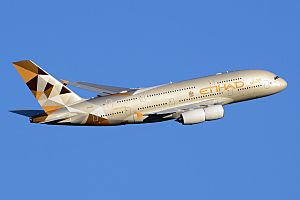
In 2009, the government started to make its economy more diverse. With high oil prices, other parts of the economy grew faster than the energy sector. Now, non-oil and gas businesses make up 64% of the UAE's total GDP. Abu Dhabi has gained the most from this trend. It is working to reduce its reliance on oil and gas. This means investing in new industries, real estate, tourism, and shopping. Free zones like Industrial City of Abu Dhabi and twofour54 media free zone have been built. There is also a big effort to promote tourism. The Abu Dhabi Tourism Authority is working on large development projects. Better transport will help these projects. A new port, a bigger airport, and a planned rail link are being developed.
Abu Dhabi is the richest of the UAE's emirates. This is based on its GDP and income per person. Over $1 trillion is invested worldwide in the city. In 2010, the GDP per person was $49,600. This ranked ninth in the world. There are no taxes for residents or non-bank, non-oil companies in Abu Dhabi. Abu Dhabi is also planning many future projects with the Cooperation Council for the Arab States of the Gulf (GCC). The UAE's economy is growing fast. In 2006, income per person grew by 9%. Abu Dhabi's sovereign wealth fund, the Abu Dhabi Investment Authority (ADIA), is the world's richest. It is estimated at $875 billion. Etihad Airways has its main office in Abu Dhabi.
Abu Dhabi's government wants to earn more money from tourism. This is why the International Airport is growing. Passenger numbers grew by over 30% in 2009. The Abu Dhabi Economic Vision 2030 also aims to diversify the economy. The plan is for the non-oil income to increase from 40% to about 70%. In July 2019, Abu Dhabi set aside $163 million for global entertainment. This is part of its plan to rely less on oil.
Many film companies use parts of the UAE for filming. Abu Dhabi has become a popular place for movies. The Etihad Towers and Emirates Palace Hotel were used in the movie Furious 7. In 2018, Abu Dhabi started Ghadan 21. This is a set of projects to make the economy more diverse. It involves 50 billion AED. The projects focus on business, society, knowledge, and lifestyle.
City Services
The Abu Dhabi Water and Electricity Authority (ADWEA) manages water and power. In 2006, it supplied 560.2 million imperial gallons of water per day. Groundwater is the most important water source. Desalinated water and treated wastewater are also used. The Umm Al Nar storage is the largest water source for Abu Dhabi. Abu Dhabi faces a big water shortage. Each resident uses about 550 liters of water daily. Abu Dhabi produces 1,532 tonnes of waste every day. This waste goes to three landfill sites.
The city's electricity use per person is about 41,000 kWh. The total power supplied was 8,367 MW in 2007. Companies like SCIPCO Power and APC Energy distribute electricity. The UAE's Energy Strategy 2050 aims to reduce carbon from power by 70%. The Noor Abu Dhabi solar park, the world's largest, was finished in July 2019. The Abu Dhabi Fire Service has 13 fire stations. They respond to about 2,000 fire and rescue calls each year.
State-owned Etisalat and private du provide phone and cell service. Cell coverage is wide. Both GSM and CDMA services are available. Etisalat used to have a monopoly on phone services. But then other companies like Du started in 2006. The Internet came to Abu Dhabi in 1995. The network has a bandwidth of 6 Gigabytes. It supports 50,000 dialup and 150,000 broadband connections.
Etisalat announced a fiber-to-the-home (FTTH) network in 2009. This would make Abu Dhabi the first city in the world with such a network.
How Abu Dhabi is Planned
Abu Dhabi was planned in the 1960s and 70s. It was meant for a maximum of 600,000 people. The city has tall apartment buildings and wide, grid-pattern roads. The most crowded part is in the north of the island. Here, main streets have many 20- to 30-story towers. These towers are in a rectangle shape. Inside, there is a grid of roads with smaller buildings. These include 2-story villas or 6-story buildings.
This planning has created a modern city. It has tall offices, apartments, wide roads, and busy shops. Important roads are the Corniche, Airport Road, Sheikh Zayed Street, Hamdan Street, and Khalifa Street. Abu Dhabi is known for its green spaces. The former desert now has many parks and gardens. The inner city roads are well-organized. Starting from the Corniche, all horizontal streets have odd numbers. All vertical streets have even numbers. So, Corniche is Street No. 1, Khalifa Street is Street No. 3, and so on. Salam Street is Street No. 8.
Mail is usually delivered to post-office boxes. But businesses can get door-to-door delivery. There are many parks in the city. Kids usually enter for free. Adults often pay a fee. The Corniche is the city's seaside walkway. It is about 10 km long. It has gardens, playgrounds, and a BMX/skateboard area.
In 2007, the Abu Dhabi Urban Planning Council (UPC) was created. This group plans Abu Dhabi's future. They made the Plan Abu Dhabi 2030. The UPC is also working on plans for other regions.
Abu Dhabi's fast growth has caused some challenges:
- The city's population is much larger than planned. This causes traffic congestion, not enough parking, and overcrowding.
- There is an addressing system, but it is not widely used. This makes it hard to find buildings. Directions are often given using nearby landmarks.
- However, a new system called Onwani is fixing the addressing system. It is making it meet international standards.
In 2023, Abu Dhabi was named the safest city in the world. This was for the sixth year in a row by Numbeo.
People of Abu Dhabi
| Historical population | ||
|---|---|---|
| Year | Pop. | ±% |
| 1960 | 25,000 | — |
| 1965 | 50,000 | +100.0% |
| 1969 | 46,400 | −7.2% |
| 1975 | 127,763 | +175.4% |
| 1980 | 243,257 | +90.4% |
| 1985 | 283,361 | +16.5% |
| 1995 | 398,695 | +40.7% |
| 2003 | 552,000 | +38.5% |
| 2009 | 896,751 | +62.5% |
| 2013 | 921,000 | +2.7% |
| 2014 | 1,205,963 | +30.9% |
| 2018 | 1,807,000 | +49.8% |
| 2023 | 3,800,000 | +110.3% |
| The town of Abu Dhabi first conducted a census in 1968. All population figures in this table prior to 1968 are estimates obtained from populstat.info. Sources: |
||
Abu Dhabi is the 67th most expensive city in the world. It is the second most expensive in the region, after Dubai.
In 2014, 477,000 out of 2,650,000 people in the emirate were UAE citizens. About 80% of the people were from other countries. The average age in the emirate was about 30.1 years. The birth rate in 2005 was 13.6%. The death rate was about 2%.
Article 7 of the UAE's Constitution says Islam is the official state religion.
Most people in Abu Dhabi are workers from other countries. They come from places like Nepal, India, Pakistan, and the Philippines. Many of these people have lived in the country for decades. Only a few have become citizens. So, languages like English, Hindi-Urdu, and Malayalam are widely spoken.
The people born in Abu Dhabi are Arabic-speaking Arabs. They are part of a clan-based society. The Al Nahyan family rules the emirate. They are very important in society. There are also Arabs from other parts of the Arab World.
Getting Around Abu Dhabi
Abu Dhabi has a growing transportation system. It has many highways that connect islands and suburbs. Public and private transport options are also expanding.
Roads and Bridges
The main Abu Dhabi island is connected by three large highways. Each has its own bridge. The oldest is Al Maqta Bridge, built in 1968. It was the first link to the island. The second, Mussafah Bridge, opened in 1977. The third, Sheikh Zayed Bridge, opened in 2010. These bridges connect the island to the Corniche Road. This is an 8 km walkway and beach at the tip of the island. As the city grows, new bridges and roads are being built. They will connect the main island to Al Maryah Island, Al Reem Island, and Saadiyat Island. For example, in 2023, the Umm Yifeenah Bridge opened. It is an 11 km highway connecting Al Reem Island to Sheikh Zayed bin Sultan Street. These changes are part of Abu Dhabi's 2030 Urban Structure Framework Plan.
Air Travel
Zayed International Airport (AUH) is the city's main airport. It is the second busiest airport in the UAE. In 2015, over 23 million travelers passed through it. A second runway and a new terminal were built recently. In July 2024, the airport launched the world's first "Smart Travel" system using biometrics.
On June 30, 2019, a multi-faith prayer room opened at Zayed International Airport. It is located away from the main airport. This helps the country be known as a place of tolerance.
Al Bateen Executive Airport also serves Abu Dhabi City. It is on the main island. It was the old international airport until AUH opened in 1982. It was updated in 2022 for private and VIP flights. It also hosts an Abu Dhabi Police search and rescue base.
Rail System
Abu Dhabi City is connected to the second phase of the Etihad Rail network. This part was finished in 2023. It is for moving goods across the seven emirates. Passenger train service has been confirmed. It will allow travel from Abu Dhabi city to other emirates. But a start date has not been set yet.
Public Transportation
Public transport in Abu Dhabi includes buses, taxis, ferries, and hydroplanes. The government plans a huge expansion of public transport. This is part of its Surface Transport Master Plan 2030. This plan includes 130 km of metro lines. It also includes 340 km of tramways and bus rapid transit (BRT) routes. The city also plans smart public transport options. These will be in areas like Yas Island and Saadiyat Island.
Abu Dhabi Bus Service
The first town bus started around 1969. On June 30, 2008, the Department of Transport began public bus service. There were four routes. Public buses also serve the airport. To get people to use buses, all rides were free until the end of 2008. The four routes run from 6 am to midnight. Buses come every 10 to 20 minutes. In the first week, many people used the buses. Some buses, which hold 45 passengers, were so full that people had to stand. Taxi drivers saw less business because of the free buses.
In 2021, the Abu Dhabi public bus system had 53.3 million passenger trips. It had a fleet of 583 buses for the city.
Smart Public Transportation
In 2022, Abu Dhabi launched self-driving public transport. This was on Yas Island and Saadiyat Island. The Saadiyat Island route stops at places like Louvre Abu Dhabi and NYU Abu Dhabi. The Yas Island route focuses on attractions like Ferrari World Abu Dhabi. This expansion includes self-driving trams, taxis, and minibuses.
In October 2023, the Integrated Transport Centre (ITC) started a test phase for the ART Service on mainland Abu Dhabi. It runs about 27 kilometers from Reem Mall to Marina Mall. It serves 25 stations.
Water Transport
The Emirate has many ports. One is Port Zayed. Others are Musaffah Port and Khalifa Port, which opened in 2012. Water transport includes water taxis and ferries. Water taxis can carry up to 12 passengers. Ferries can carry up to 100 passengers. Water taxis offer quick trips across the city's waterways. Ferries are a nice way to travel between islands and the mainland.
In 2021, 114,093 passengers used public ferries.
Toll Gates
In 2021, Abu Dhabi started using four toll gates. These are on all bridges entering the main Abu Dhabi island. They only work during busy hours. By the end of 2021, over 1.8 million cars were registered. Crossing a toll gate costs 4 AED. Abu Dhabi's toll gate system is called Darb. It aims to reduce traffic and make traffic flow smoother. Drivers must register their cars on the Darb app or website. The system automatically takes the toll from a prepaid account.
Abu Dhabi's Culture
Abu Dhabi has a diverse society with many cultures. It used to be a small community of pearl divers. But then people from other countries arrived. First, Iranians came in the early 1900s. Later, people from Asia and Europe came in the 1950s and 1960s. Major holidays in Abu Dhabi include Eid al Fitr, which ends Ramadan. Also, Eid ul-Adha marks the end of Hajj. National Day (December 2) celebrates the forming of the UAE.
Abu Dhabi is generally more accepting than its neighbors, like Saudi Arabia. Emiratis are known for being tolerant. Christian churches, Hindu temples, and Sikh gurdwaras can be found next to mosques. The first synagogue started being built in 2020. The city is becoming more global. So, there are many Asian, European, and Western schools. There are also cultural centers and themed restaurants.
Abu Dhabi has several cultural places. These include the Cultural Foundation and the National Theater. The Cultural Foundation is home to the UAE Public Library and Cultural Center. Groups like the Abu Dhabi Classical Music Society are popular. The Emirates Foundation gives money to support arts and science. It also helps with education and protecting the environment. The International Prize for Arabic Fiction (IPAF) will be based in Abu Dhabi. The city also hosts many conferences and exhibitions each year. The Abu Dhabi National Exhibition Centre (ADNEC) is the largest exhibition center in the Persian Gulf. It welcomes about 1.8 million visitors yearly.
The Red Bull Air Race World Series has been a big sports event for the city. It brings many thousands of people to the waterfront. Another major event is the Abu Dhabi International Petroleum Exhibition and Conference (ADIPEC).
The food in Abu Dhabi shows its many cultures. Arab food is very popular. You can find it everywhere, from small shawarma shops to fancy hotel restaurants. Fast food and South Asian cuisine are also popular. Selling and eating pork is allowed but controlled. It is sold only to non-Muslims in special areas. Selling alcoholic beverages is also controlled. You need a permit to buy alcohol. But alcohol is available in bars and restaurants in four or five-star hotels. Shisha and qahwa (coffee) shops are also popular.
Poetry is highly valued in Abu Dhabi and the UAE. It often talks about humor, religion, family, bravery, and love. Sheikhs, teachers, sailors, and princes have been important poets in the UAE. Al Khalil bin Ahmed created a unique form of poetry in the 8th century. Another Emirati poet, Ibn Daher, lived in the 17th century. Daher is important because he used Nabati poetry. This poetry is written in everyday Arabic, not classical Arabic. Other important poets from the UAE are Mubarak Al Oqaili (1880–1954), Salem bin Ali al Owais (1887–1959), and Abdulla bin Sulayem (1905–1976). These poets wrote in Classical Arabic poetry.
Today, the Abu Dhabi Cultural Foundation works to keep the city's art and culture alive. Since 2010, Abu Dhabi has become a major place for film companies to shoot movies. Some famous films shot in Abu Dhabi include Furious 7 (2015), Star Wars: The Force Awakens (2015), and Dune (2021).
Learning in Abu Dhabi
Abu Dhabi has many international and local private schools and universities. These include INSEAD, New York University Abu Dhabi, Khalifa University, Higher Colleges of Technology, Sorbonne University Abu Dhabi, and Abu Dhabi University. New York University opened a campus in Abu Dhabi in September 2010.
All schools in the emirate are managed by the Abu Dhabi Education Council. This group oversees public schools. It also licenses and checks private schools. Since 2009, the council has brought in thousands of teachers. They come from English-speaking countries to help with the New School Model Program.
Every year, there is an exhibition at the Abu Dhabi Exhibition Center. Universities from all over the world show their programs. They also offer scholarship programs. Universities like Heriot-Watt University and Oxford University attend.
In October 2019, Abu Dhabi announced the world's first graduate-level AI research school. It is called Mohamed bin Zayed University of Artificial Intelligence (MBZUAI). It helps students, businesses, and governments improve artificial intelligence. The university started taking applications a year before classes began in September 2020.
Sports in Abu Dhabi
Abu Dhabi has a growing sports culture. It invests in sports facilities and hosts big global sports events. Traditional sports like camel racing and horse riding are popular. Modern sports like Jiu-jitsu and football are also well-loved. Abu Dhabi follows the UAE's National Sport Strategy 2031. This plan aims to get more people involved in sports. It also wants to increase the types and number of sports facilities.
Zayed Sport City
Zayed Sport City is a large complex in Abu Dhabi city. It has many properties and sports facilities. It encourages people to play sports. ZSC offers places for basketball, billiards, football, and paintball. It also has an ice rink. The complex is home to the Zayed Sports City Stadium. This is the largest stadium in the UAE. It can seat 45,000 people. It is also the main office for the Abu Dhabi Sports Council. This council hosts events in the city. The Mubadala Arena is also here. It is home to the UAE Jiu Jitsu team.
Jiu Jitsu
Jiu Jitsu is a popular sport in the city. It has a special complex in the Mubadala Arena. Jiu Jitsu is a "Soft Art" that came from ancient Japanese martial arts. It was adopted by Brazil in the early 1900s. Jiu Jitsu does not use punches or kicks. Instead, it uses techniques like throws, control positions, and locks. The Abu Dhabi government's Abu Dhabi Education Council (ADEC) has a program for students interested in Jiu Jitsu. The Abu Dhabi Jiujitsu Schools Program started in 2008. It was supported by the crown prince (now President) Mohammed bin Zayed Al Nahyan. He is a big fan of Brazilian jiu-jitsu. The program started in 14 schools. It has grown to 42 government schools. 81 Brazilian coaches teach the sport.
Students aged 9 to 13 learn Brazilian jiu-jitsu as part of their school lessons. The plan was for up to 500 schools to join the program by 2015. Sheikh Mohammad bin Zayed Al Nahyan asked for this project.
Football
Football is the most popular sport in the city. Abu Dhabi has four football stadiums. These are Al Jazeera Stadium, Al Wahda Stadium, Sheikh Zayed Football Stadium, and Hazza Stadium. The city is home to the Al Jazira Club, Al Wahda FC, and Baniyas Club. All these teams play in the UAE Pro League. The city has also hosted international football events. These include five FIFA Club World Cup tournaments and the 2019 AFC Asian Cup.
Abu Dhabi Formula 1 Grand Prix
The city hosts the Abu Dhabi Grand Prix for Formula One racing. It has been held at the Yas Marina Circuit since 2009. The race happens late in the Formula One season, usually in November or December. It is often the last race of the season. The Yas Marina Circuit is one of the most expensive race tracks ever built. It also hosts other local races and tours.
Abu Dhabi Grand Slam
Abu Dhabi often hosts the International Judo Federation Abu Dhabi grand slam. In 2017, the International Judo Federation did not allow the Israeli flag or anthem. This caused some criticism. The ban on Israeli symbols was lifted in 2018. The Israeli flag and anthem were then allowed. The Israeli sports minister, Miri Regev, was also allowed to attend.
Special Olympics World Games Abu Dhabi 2019
In March 2019, Abu Dhabi hosted the first Special Olympics World Games in the Middle East. The event was from March 14 to 21, 2019. Over 7,500 athletes took part in 24 sports. The official World Games Flame of Hope was lit in Athens. It was then flown to Abu Dhabi. From there, it traveled through all seven emirates of the UAE. It was the first time the Special Olympics World Games were held in the Middle East. Over 2,500 coaches and 20,000 volunteers helped at the Olympics.
Other Sporting Events
The city has hosted many international cricket tournaments. These include the ICC Men's T20 World Cup. It also hosts the Mubadala World Tennis Championship.
Fun Places to Visit
Abu Dhabi has many interesting places to see. These include the Sheikh Zayed Grand Mosque and Mariam Umm Eisa Mosque. You can also visit Emirates Palace, Qasr Al Watan, and Yas Marina Circuit. Other popular spots are The Corniche, Etihad Towers, Yas Marina, and Yas Waterworld Abu Dhabi. Don't forget Ferrari World Abu Dhabi, Louvre Abu Dhabi, Yas Island, Saadiyat Island, Warner Bros. World Abu Dhabi, SeaWorld Abu Dhabi, and Jubail Mangrove Park.
On April 29, 2022, Abu Dhabi announced that businesses, tourist places, and events could operate at 100% capacity.
See also
 In Spanish: Abu Dabi para niños
In Spanish: Abu Dabi para niños


